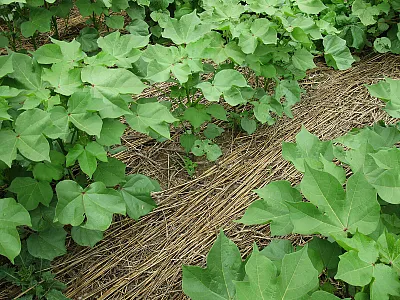Growing spring peas to increase soil organic carbon in eastern Oregon’s dryland wheat systems
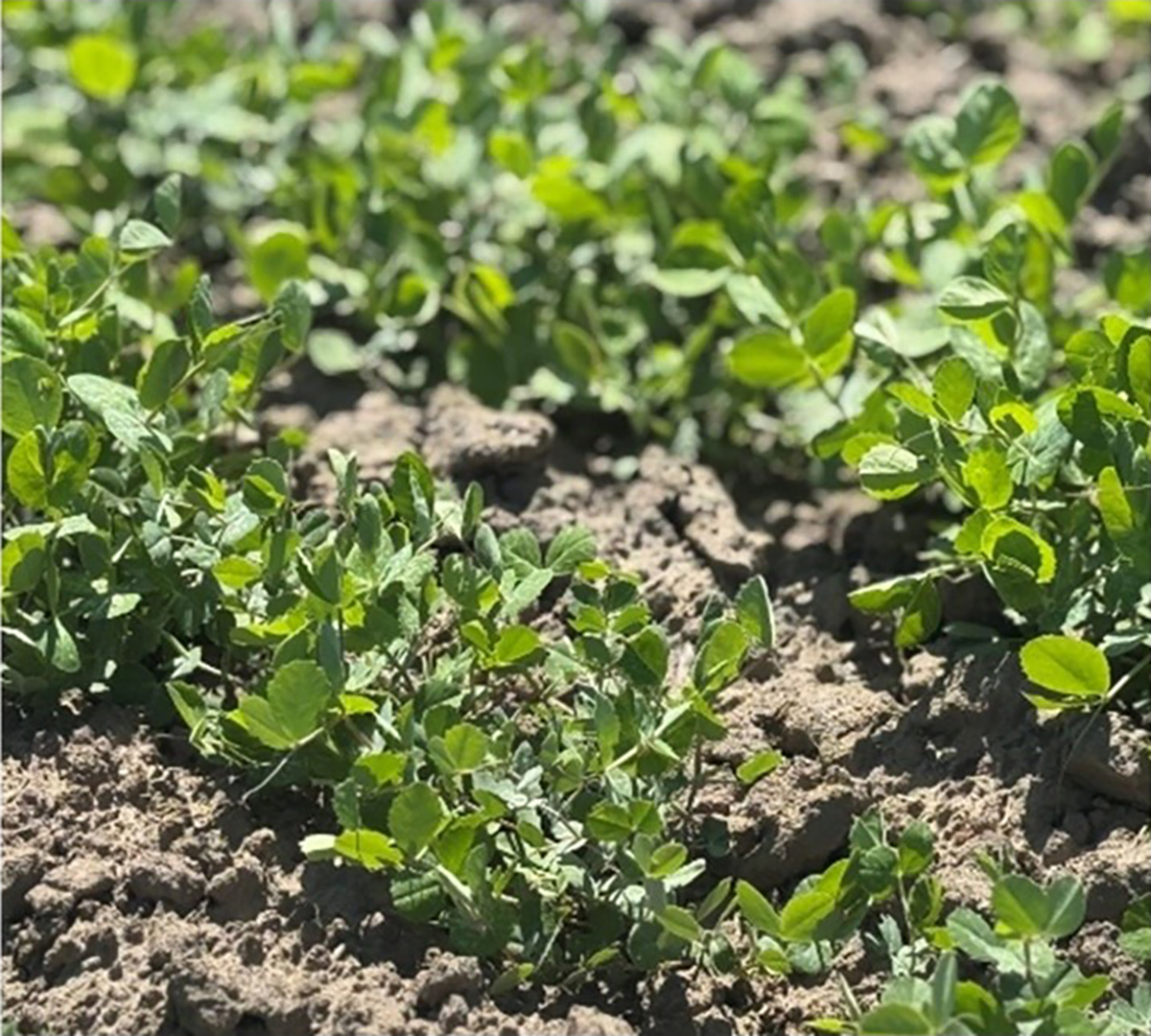

Wheat farmers in eastern Oregon are exploring ways to improve soil health and restore lost carbon in dryland systems dominated by winter wheat–summer fallow rotations. This article highlights long-term research showing that rotating wheat with spring peas can significantly increase soil carbon, especially the more stable mineral-associated organic matter. By comparing tillage methods and crop rotations, the study offers insights into how legume integration can enhance sustainability and productivity in the Inland Pacific Northwest.
Earn 0.5 CEUs in Soil & Water Management by reading this article and taking the quiz.
Wheat farmers in Eastern Oregon, part of the Inland Pacific Northwest (iPNW), face the challenge of maintaining healthy soil while sustaining crop production, especially in the dryland region of the iPNW. Due to limited moisture, a winter wheat–summer fallow (WW-SF) cropping system has been adopted widely in the region where land is left fallow for 13–14 months between two wheat crops. Although the WW-SF system provides reliable yields, it is associated with a decline in total soil carbon (C), increased soil erosion, increased herbicide-resistant weeds, and a decline in overall soil health.
Long-term studies conducted at Oregon State University’s Columbia Basin Agricultural Research Center in Pendleton, OR (CBARC) show that dryland farming practices, particularly long fallow periods and intensive tillage, have resulted in significant losses of inherent soil organic C and essential soil nutrients in winter wheat systems. Over the past century, up to 60% of the inherent C and N have been lost (Ghimire et al., 2018). For decades, farmers have often left fields fallow to conserve soil moisture (Schillinger & Papendick, 2008). While that can help in the short term, it also leads to nutrient loss over time, weakening soil health and reducing crop productivity, creating both challenges and a valuable opportunity for restoring C in eastern Oregon.
These challenges are encouraging farmers to diversify traditional WW-SF systems. One promising approach is to incorporate spring peas into a crop rotation strategy that can enhance soil fertility, increase soil C, provide better weed control, break disease and pest cycles, and increase long-term resilience. Spring peas are particularly well-suited for the cold, dry climate of eastern Oregon. They were historically a significant part of local cropping systems, commonly grown in rotation with wheat from the early to mid-1900s (Rasmussen & Smiley, 2019). Although to some extent studies have been done on how including spring peas into WW-SF systems affect C, N, crop yields, and weed control, research-based information on the role of spring peas in sequestrating long-term C in the dryland region is limited.
Therefore, this study explores (i) how legumes like spring peas fit into wheat rotations and (ii) how different tillage methods impact C compared with the WW-SF system. A key focus of this study is the different types of soil organic C fractions: (i) particulate organic matter (POM) that breaks down quickly and (ii) mineral-associated organic matter (MAOM) that binds to minerals and locks in carbon for the long term. This study focused on total C and MAOM-C under different treatments.
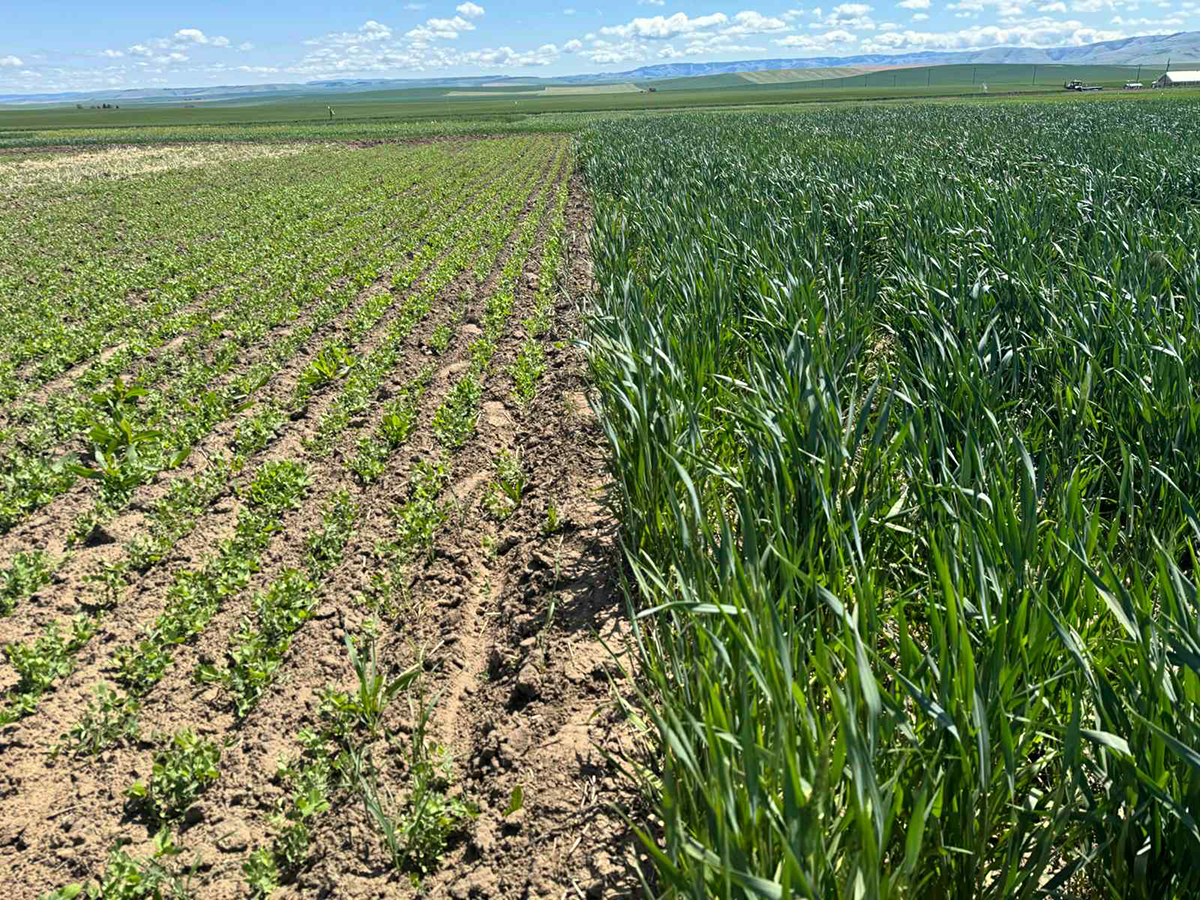
Methodology
Soils at the study site are classified as Walla Walla silt loam and receive 421 mm of annual precipitation. This study uses data from several long-term experiments (LTEs) conducted at CBARC, some of which have been ongoing since 1931. One of the LTEs, the winter wheat–spring pea rotation (WW-SP), established in 1963, was designed to evaluate the impact of rotating wheat with peas under varying tillage intensities on soil health and wheat productivity. The study focuses on two tillage practices within a WW-SP rotation: conventional tillage (CT), involving fall moldboard plowing since 1963, and no-till (NT), which began as minimum tillage and transitioned to full no-till by 1995.
In the WW-SP rotation, wheat was planted in October with 80 lb N/ac applied, and peas were sown between March and April. The CT system involved plowing in the fall to turn over the soil, incorporating the crop residue, and cultivating in the spring. To provide a comprehensive understanding, we also compared these rotations to a long-term CT WW-SF system established in 1931 at CBARC. In this system, wheat received 80 lb N/ac with fall plowing, spring cultivation, and residue incorporation practiced during fallow years.
To understand how soil C has changed over time, we analyzed archived soil samples collected as far back as 1963 and measured C levels in the top 12 inches (30 cm) of the soil. Total C and MAOM-C were measured using the dry combustion method.
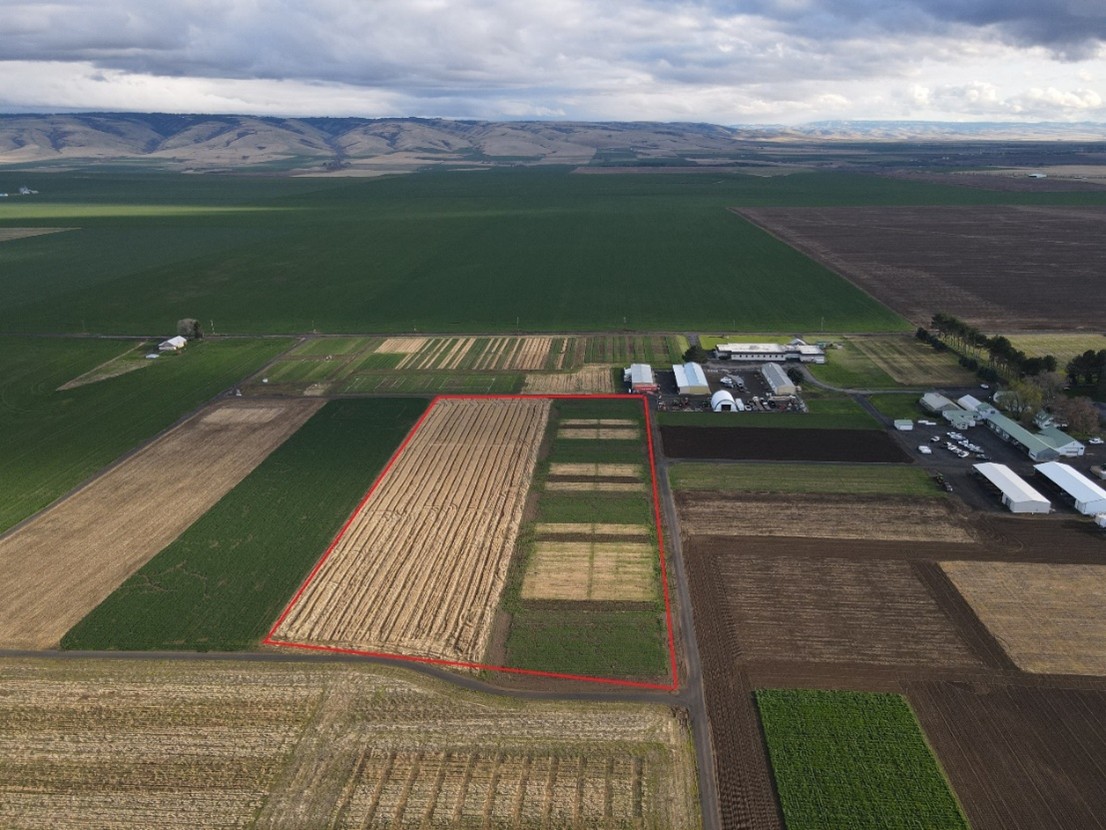
Main findings
Nearly 60 years of research indicate that rotating wheat with spring peas consistently increases soil C in the top 12 inches. When farmers shift from the traditional WW-SF system to a wheat–legume (WW-SP) rotation, soil C increases annually by at least 0.07 tons/ac under CT and 0.11 tons/ac under NT. This is a substantial improvement compared with the WW-SF system, which continued to lose C at a rate of 0.45 tons/ac annually.
One important finding is that including spring peas in the rotation resulted in an effective way to build durable, long-lasting soil C, specifically MAOM-C (Figure 1). Even in tilled systems, MAOM levels increased when spring peas were included in the rotation and continued to decline under continuous wheat–fallow systems. The shift from WW-SF to WW-SP increased bulk soil C by ~38% and MAOM-C by ~60%. This is significant given the major role MAOM plays in building more resilient soils. Although legumes in rotation contribute modest C gains, they play a crucial role in reversing C losses and enhancing the formation of the persistent organic matter fraction such MAOM-C.
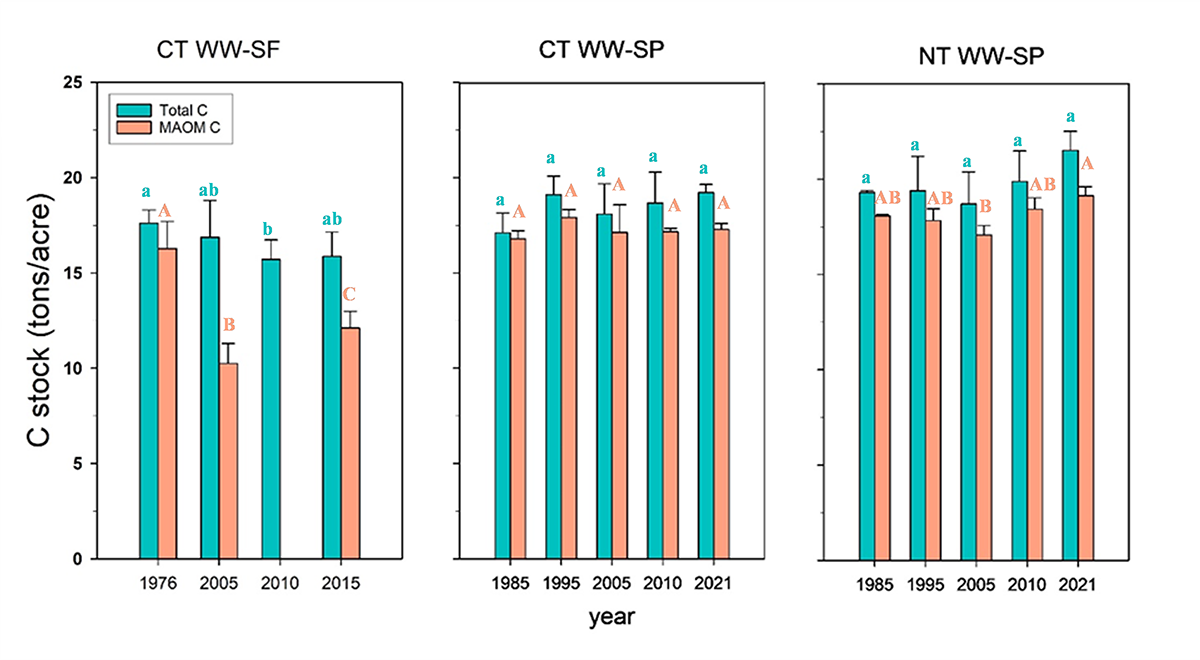
Spring pea rotations also helped soils retain more N near the topsoil, resulting in a reduced need for synthetic fertilizers and increased availability of N for the next crop. Contrary to common belief in these areas, legumes provided these benefits without depleting soil moisture or reducing the performance of subsequent wheat crops. Overall, these benefits make spring peas an effective, climate-smart tool for improving soil health and sequestering C for the long term in dryland wheat-based systems.
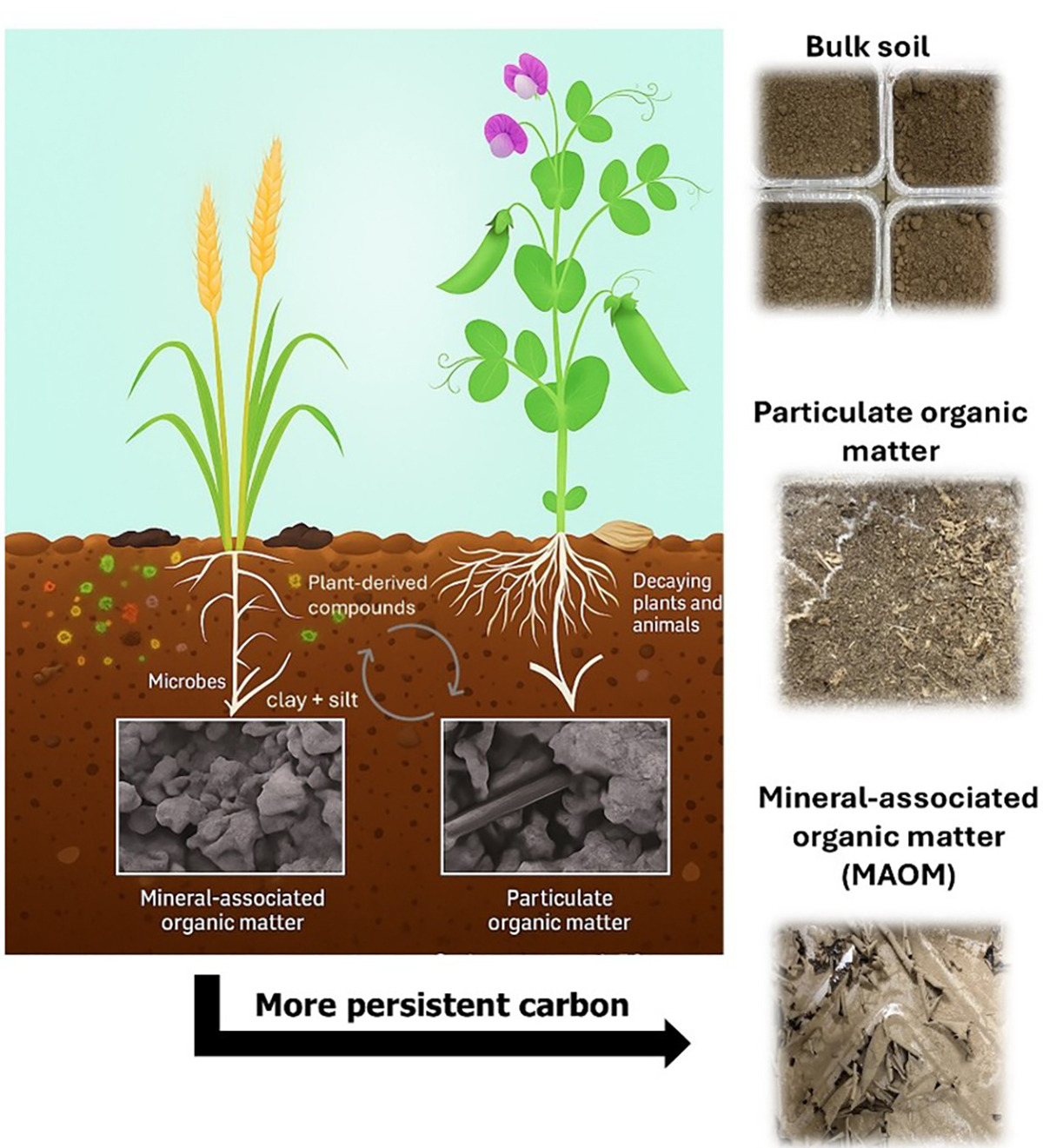
Why it matters for growers
While estimates for soil C sequestration can sometimes seem overly optimistic, the study's results demonstrate that even with conventional tillage, realistic and measurable gains in stable, long-lasting soil C is achievable in a wheat–pea cropping system. These rotations help build stable, long-lasting soil C, which improves soil structure, water retention, nutrient cycling, and microbial activity. In practical terms, this leads to healthier, more resilient soils that remain productive even under drought stress.
The study's results demonstrate that even with conventional tillage, realistic and measurable gains in stable, long-lasting soil C is achievable in a wheat–pea cropping system."
Spring peas also offer flexibility for growers as they can be grown for grain, forage, or as green manure—all while benefiting soil health in the long-term. Wheat yields for WW-SF rotations respond poorly to moisture with no significant gains in dry years and lower performance in wet years compared with legume-integrated systems. As C markets and incentive programs expand, the measured gains in C and organic matter from WW-SP systems make this rotation an attractive option for potential credit opportunities.
Eastern Oregon has lost a large amount of its soil C since the beginning of soil cultivation, but this loss creates a significant opportunity for restoration. Replacing summer fallow with spring peas is recommended as a practical step toward regenerative agriculture, improving soil health, crop performance, and climate resilience.
Dig deeper
Ramírez, P.B., Calderón, F., Singh, S., & Machado, S. (2025). Legume-based rotation enhance long-term soil carbon storage in eastern Oregon dryland wheat systems. Scientific Reports, 15, 13842. https://doi.org/10.1038/s41598-025-98916-x
Ghimire, R., Machado, S., & Bista, P. (2018). Decline in soil organic carbon and nitrogen limits yield in wheat-fallow systems. Plant and Soil, 422(1–2), 423–435. https://doi.org/10.1007/s11104-017-3470-z
Rasmussen, P. E., & Smiley, R. W. (2019). Soil carbon and nitrogen change in long-term agricultural experiments at Pendleton, Oregon. In E.A. Paul, K.H. Paustian, E.T. Elliott & C.V. Cole (Eds.), Soil organic matter in temperate agroecosystems (pp. 353–360). Taylor and Francis. https://doi.org/10.1201/9780367811693-26
Schillinger, W. F., & Papendick, R. I. (2008). Then and now: 125 years of dryland wheat farming in the Inland Pacific Northwest. Agronomy Journal,100, S-166–S-182. https://doi.org/10.2134/agronj2007.0027c
Self-study CEU quiz
Earn 0.5 CEUs in Soil & Water Management by taking the quiz for the article. For your convenience, the quiz is printed below. The CEU can be purchased individually, or you can access as part of your Online Classroom Subscription.
1. What is one main reason farmers in eastern Oregon have traditionally used the winter wheat–summer fallow (WW-SF) system?
a. To conserve soil moisture in a dry climate.
b. To maximize use of synthetic fertilizers.
c. To grow more legumes.
d. To maintain high organic matter levels.
2. Which of the following is NOT a benefit of including spring peas in crop rotation?
a. Improved soil fertility.
b. Increased herbicide resistance.
c. Better weed control.
d. Enhanced long-term soil resilience.
3. Wheat yields for WW-SF rotations respond poorly to moisture with no significant gains in dry years.
a. True.
b. False.
4. What type of soil carbon is most stable and binds to minerals?
a. Volatile organic carbon.
b. Soluble carbon fraction.
c. Particulate organic matter (POM).
d. Mineral-associated organic matter (MAOM).
5. When farmers shift from the traditional winter wheat–summer fallow (WW-SF) system to a wheat–legume (WW-SP) rotation, what happens to soil C?
a. It decreases by 0.45 tons/ac annually.
b. It increases annually between 0.07 and 0.11 tons/ac, depending on tillage system.
c. It decreases annually by 0.07 tons/ac under conventional tillage and increases annually by 0.45 tons/ac under no-tillage.
d. There is no change.
Text © . The authors. CC BY-NC-ND 4.0. Except where otherwise noted, images are subject to copyright. Any reuse without express permission from the copyright owner is prohibited.





